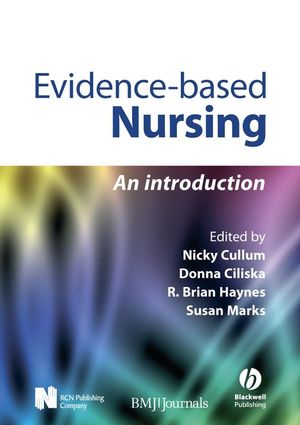Evidence-Based Nursing: An IntroductionISBN: 978-1-4051-4597-8
Paperback
336 pages
December 2007, Wiley-Blackwell
 This is a Print-on-Demand title. It will be printed specifically to fill your order. Please allow an additional 10-15 days delivery time. The book is not returnable.
|
||||||
2. Implementing evidence-based nursing: some misconceptions.
3. Asking answerable questions.
4. Searching for the best evidence. Part 1: where to look.
5. Searching for the best evidence. Part 2: searching CINAHL and Medline.
6. Of Studies, Summaries, Synopses, and Systems: the “4S” evolution of services for finding current best evidence.
7. Identifying the best research design to fit the question. Part 1: quantitative designs.
8. Identifying the best research design to fit the question. Part 2: qualitative designs.
9. If you could just provide me with a sample: examining sampling in qualitative and quantitative research papers.
10. The fundamentals of quantitative measurement.
11. Statistics for evidence-based nursing.
12. Estimating treatment effects: real or the result of chance?.
13. Data analysis in qualitative research.
14. Users' guides to the nursing literature: an introduction.
15. Evaluation of studies of treatment or prevention interventions.
16. Assessing allocation concealment and blinding in randomised controlled trials: why bother?.
17. Clinically useful measures of the effects of treatment.
18. "Double blind, you are the weakest link — goodbye!".
19. Evaluation of systematic reviews of treatment or prevention interventions.
20. Evaluation of studies of assessment and screening tools, and diagnostic tests.
21. Evaluation of studies of health economics.
22. Evaluation of studies of prognosis.
23. Evaluation of studies of causation (aetiology).
24. Evaluation of studies of harm.
25. Evaluation of qualitative research studies.
26. Evaluation of clinical practice guidelines.
27. Closing the gap between nursing research and practice.
28. Promoting research utilisation in nursing: the role of the individual, organisation, and environment.
29. Nurses, information use, and clinical decision making—the real world potential for evidence-based decisions in nursing.
The following are tentative depending on emphasis on implementation:.
30. Clinical practice guidelines.
31. Continuing professional development in Canada and the UK: how evidence-based resources can help.
32. Centres of evidence-based nursing: directions and challenges.
33. Developing organisational systems and culture to support evidence-based practice: the experience of the Evidence-Based Ward Project.
34. Building a foundation for evidence-based practice: experiences in a tertiary hospital



